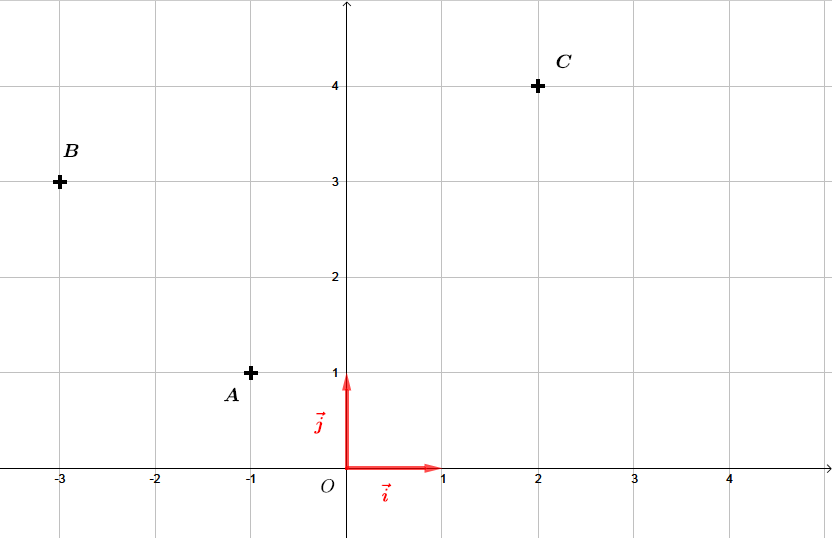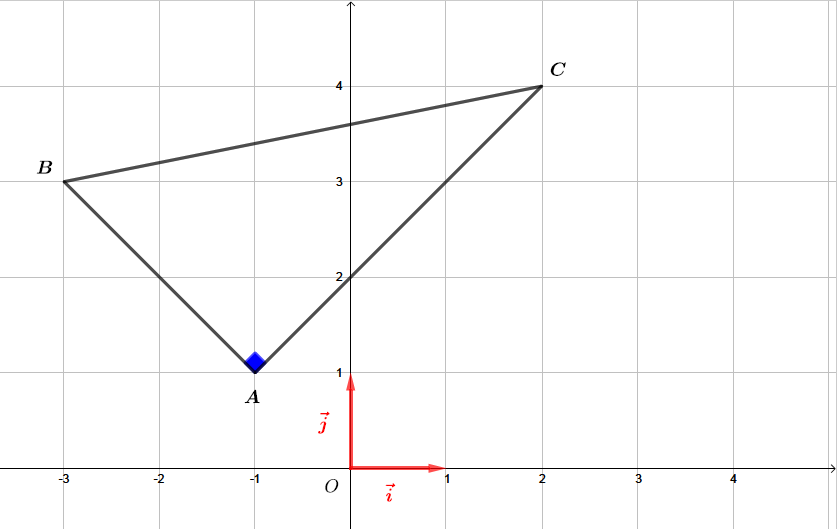Calculons les longueurs des trois côtés du triangle
A B C ABC A BC .
Soit
( 0 ; i → ; j → ) \left(0;\overrightarrow{i} ;\overrightarrow{j} \right) ( 0 ; i ; j ) un repère
orthonormal du plan et deux points
A ( x A ; y A ) A\left(x_{A} ;y_{A} \right) A ( x A ; y A ) et
B ( x B ; y B ) B\left(x_{B} ;y_{B} \right) B ( x B ; y B ) . La
distance A B AB A B est donnée par la formule :
A B = ( x B − x A ) 2 + ( y B − y A ) 2 AB=\sqrt{\left(x_{B} -x_{A} \right)^{2} +\left(y_{B} -y_{A} \right)^{2} } A B = ( x B − x A ) 2 + ( y B − y A ) 2 Ainsi :
A B = ( x B − x A ) 2 + ( y B − y A ) 2 ⇔ A B = ( − 3 − ( − 1 ) ) 2 + ( 3 − 1 ) 2 ⇔ A B = ( − 2 ) 2 + 2 2 AB=\sqrt{\left(x_{B} -x_{A} \right)^{2} +\left(y_{B} -y_{A} \right)^{2} }\Leftrightarrow AB=\sqrt{\left(-3-\left(-1\right)\right)^{2} +\left(3-1\right)^{2} } \Leftrightarrow AB=\sqrt{\left(-2\right)^{2} +2^{2} } A B = ( x B − x A ) 2 + ( y B − y A ) 2 ⇔ A B = ( − 3 − ( − 1 ) ) 2 + ( 3 − 1 ) 2 ⇔ A B = ( − 2 ) 2 + 2 2 D'où :
A C = ( x C − x A ) 2 + ( y C − y A ) 2 ⇔ A C = ( 2 − ( − 1 ) ) 2 + ( 4 − 1 ) 2 ⇔ A C = 3 2 + 3 2 AC=\sqrt{\left(x_{C} -x_{A} \right)^{2} +\left(y_{C} -y_{A} \right)^{2} }\Leftrightarrow AC=\sqrt{\left(2-\left(-1\right)\right)^{2} +\left(4-1\right)^{2} } \Leftrightarrow AC=\sqrt{3^{2} +3^{2} } A C = ( x C − x A ) 2 + ( y C − y A ) 2 ⇔ A C = ( 2 − ( − 1 ) ) 2 + ( 4 − 1 ) 2 ⇔ A C = 3 2 + 3 2 D'où :
B C = ( x C − x B ) 2 + ( y C − y B ) 2 ⇔ B C = ( 2 − ( − 3 ) ) 2 + ( 4 − 3 ) 2 ⇔ B C = 5 2 + 1 2 BC=\sqrt{\left(x_{C} -x_{B} \right)^{2} +\left(y_{C} -y_{B} \right)^{2} }\Leftrightarrow BC=\sqrt{\left(2-\left(-3\right)\right)^{2} +\left(4-3\right)^{2} } \Leftrightarrow BC=\sqrt{5^{2} +1^{2} } BC = ( x C − x B ) 2 + ( y C − y B ) 2 ⇔ BC = ( 2 − ( − 3 ) ) 2 + ( 4 − 3 ) 2 ⇔ BC = 5 2 + 1 2 D'où :
D’une part : \red{\text{D'une part :}} D’une part : B C 2 = ( 26 ) 2 = 26 BC^{2}=\left(\sqrt{26}\right)^{2}=26 B C 2 = ( 26 ) 2 = 26 D’autre part : \red{\text{D'autre part :}} D’autre part : A C 2 + A B 2 = ( 18 ) 2 + ( 8 ) 2 AC^{2}+AB^{2}=\left(\sqrt{18}\right)^{2}+\left(\sqrt{8}\right)^{2} A C 2 + A B 2 = ( 18 ) 2 + ( 8 ) 2 ainsi :
A C 2 + A B 2 = 18 + 8 = 26 AC^{2}+AB^{2}=18+8=26 A C 2 + A B 2 = 18 + 8 = 26 Il en résulte donc que :
B C 2 = A B 2 + A C 2 BC^{2} =AB^{2} +AC^{2} B C 2 = A B 2 + A C 2 alors, d’après
la réciproque du théorème de Pythagore , le triangle
A B C ABC A BC est rectangle en
A A A .


